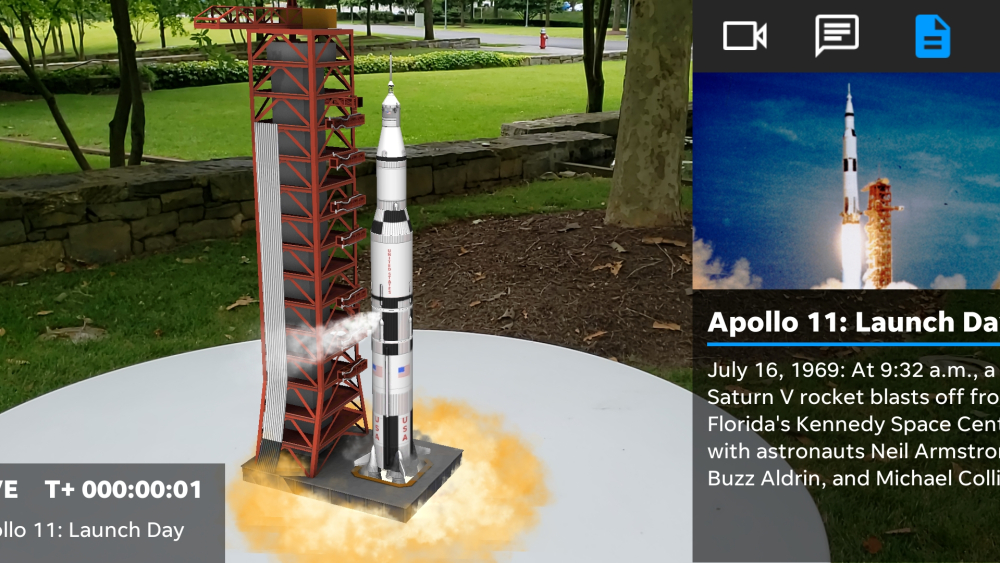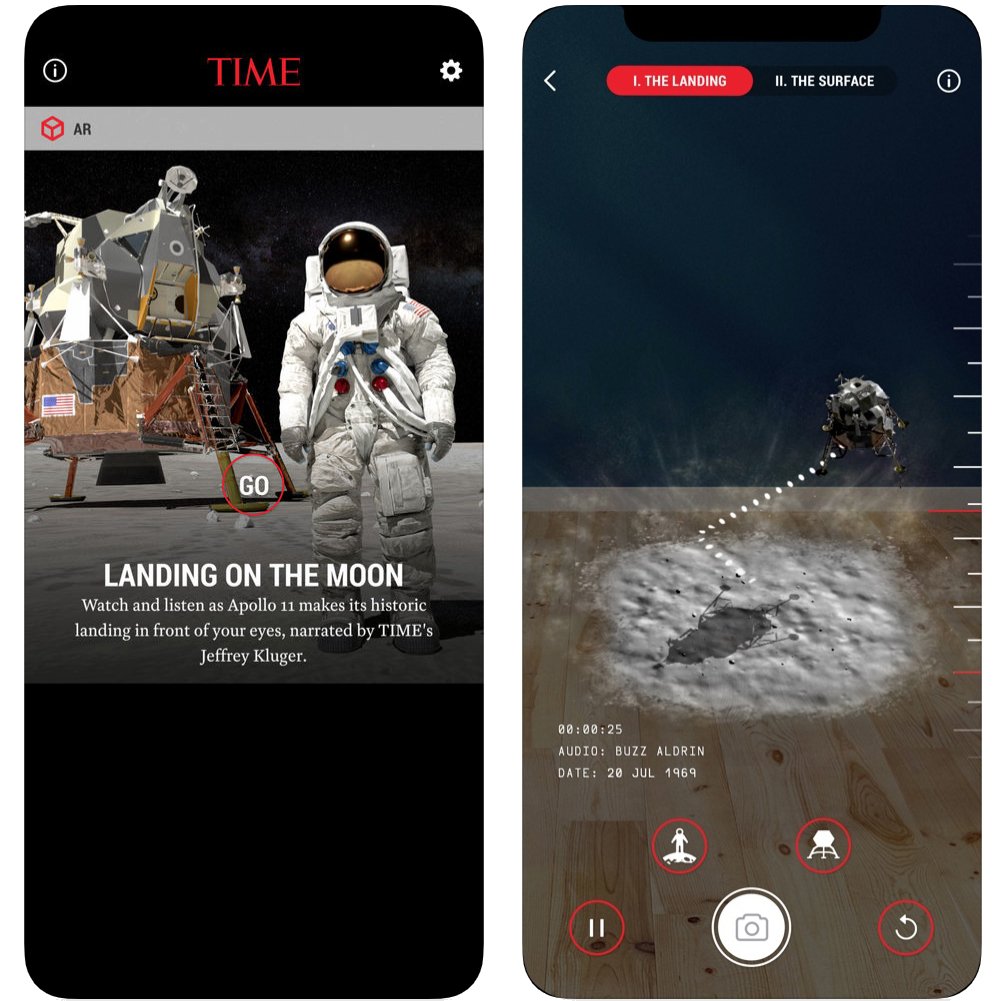Time Magazine Launches Immersive App With Apollo 11 AR Landing Experience
TIME Magazine continues to deliver ever sophisticated technical innovations by tapping into emerging tech to deliver content to its users.
The weekly publication has now created its first immersive app that will deliver both virtual reality and augmented reality experiences to its readers. This immersive project has been a year in the making and is now ready for launch.
The first experience on the app will be a 3D recreation of the historic Apollo 11 moon-landing named the TIME Moon Landing Experience. The 50th anniversary of the moon landing will be marked on July 20th and many organizations, including NASA and the Smithsonian are coming up with various streaming and broadcast projects, some of which tap on immersive tech, to commemorate that historic occasion. TIME Magazine is just the latest to hop onto the bandwagon with its own augmented reality rendering of the experience in its upcoming issue.

Time Magazine has rendered the imaging through the use of 3D assets that have been developed over a duration of 20 years by Photoshop co-founder John Kroll who leveraged data sets from NASA for the initiative. The magazine has described its 3D rendering of the moon landing as “the world’s most accurate re-creation” of the event.
According to TIME, this hyper-accurate augmented reality rendering of the moon landing mission is due to the fact that at its core, it relies on very precise data that has been collected meticulously over the past 20 years by John Kroll who is the visual effects supervisor and chief creative officer at Industrial Light and Magic (ILM), a leading special effects company in Hollywood founded by George Lucas.
Knoll started collecting the Apollo 11 moon landing data after chancing upon a transcript of the radio calls between the spacecraft and mission control. The transcripts capture the hair-raising and suspense-filled minutes just before the “Eagle” lander touched the lunar surface and at a time when it was dangerously running low on fuel. The time-stamped transcripts clearly bring out this critical moment which has been overlooked over the past decades.
To realize a technically-accurate recreation, Knoll relied on a few data sources such as the NASA telemetry graphs, the footage from the descent camera on the lunar module (LEM) as well as data from the Lunar Reconnaissance Orbiter (LRO), a probe which orbits the moon and which was landed in 2009. The shortcomings in the sparse data was compensated for through advanced computer vision techniques such as a process where the altitude of the features on the lunar surface were estimated from their dark and bright impressions in the photographs.

Time’s new immersive mobile app was launched on Thursday along with its augmented reality experience that will enable users to visualize the moon landing inside their living rooms. The TIME Moon Landing Experience will be available on the immersive app which can be downloaded free from either Android or iOS. The app will be TIME’s new channel for both augmented and virtual reality experiences that will be created by the magazine’s visual storytellers and which will take the Magazine’s content to a new era of immersive journalism for its readers, many of whom will soon be hopping onto immersive experiences via the mobile phones or VR and AR hardware.
With the TIME Moon Landing Experience, the magazine will offer its readers a first glimpse into the future of its content. They will be able to view the tabletop recreation of the famous moon landing in augmented reality mode. The experience will include not only the original landing procedure complete with the original audio from 50 years ago but users will also be immersed into an experience where they will accompany Neil Armstrong as he makes his first steps on the lunar surface in this AR recreation.
Users will watch roughly 5 minutes of an augmented reality simulation of the original moon landing in 1969. The experience will be narrated by Jeffrey Kluger of TIME magazine and will feature the original NASA audio from that mission 50 years ago. They will then be able to use augmented reality explore the lunar surface on their own.
The augmented reality experience was produced by time in collaboration with the mixed reality agency Trigger, John Knoll, the Smithsonian’s Digitization Program Office along with the Smithsonian’s National Air Space and Space Museum. Other partners in the project included Yahoo News and Ryot.
Knoll’s involvement in the project was particularly crucial as it ensured the team was able to recreate the event with some great scientific accuracy. Knoll, who is currently the chief creative at ILM, is also a well-known moon buff who has been researching the Apollo 11 mission for the past 20 years after he chanced upon a website containing raw telemetry data from the moon landing.
The current research also forms part of the lofty HoloLens demo of the moon landing that Knoll produced in collaboration with Epic Games and Microsoft.
Apart from highlighting in detail what actually took place in 1969, the TIME AR recreation will also enable viewers to appreciate the complexity of the project.
This TIME experience isn’t the only such augmented reality recreation of the moon landing. There is also the Florida Today and USA Today augmented reality livestream of the real-time recreation of the moon landing that was launched earlier in the week as part of the 321 Launch app along with the Moonshot AR app by the John F. Kennedy Presidential Library which has been performing augmented reality broadcasts that will be running for 120 hours culminating in a moon-landing on the anniversary date of 10th July.
You can access the experience through the TIME Immersive app which can be downloaded freely from the Apple’s App Store for iPhones and Google Play Store for Android devices.
https://virtualrealitytimes.com/2019/07/19/time-magazine-launches-immersive-app-with-apollo-11-ar-landing-experience/https://virtualrealitytimes.com/wp-content/uploads/2019/07/TIME-Immersive-AR-App-600x600.jpghttps://virtualrealitytimes.com/wp-content/uploads/2019/07/TIME-Immersive-AR-App-150x90.jpgAugmented RealityTechnologyTIME Magazine continues to deliver ever sophisticated technical innovations by tapping into emerging tech to deliver content to its users. The weekly publication has now created its first immersive app that will deliver both virtual reality and augmented reality experiences to its readers. This immersive project has been a year...Sam OchanjiSam Ochanji[email protected]EditorVirtual Reality Times - Metaverse & VR
